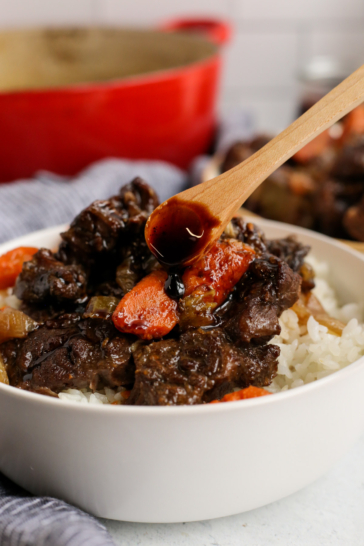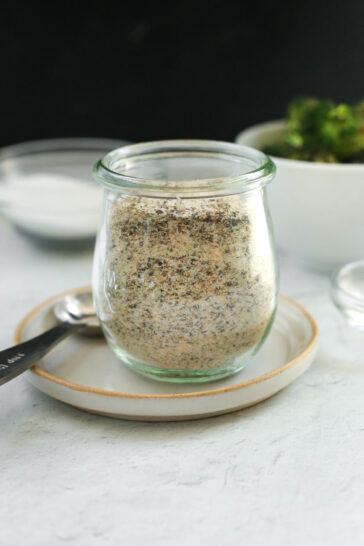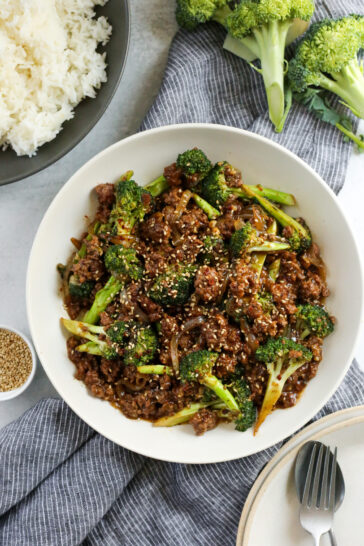As a dietitian, I’m always curious about where food comes from. In this post, it’s all about beef sustainability! Read more to learn what beef ranchers are doing to provide safe, high-quality beef in an environmentally-conscious way.
Disclosure: This interview was facilitated by Kansas Farm Bureau and I was compensated for my time.
As a dietitian based in the Midwest, I’m fortunate to have access to the larger food system within a short drive of where I live. Although I grew up in a rural area, I didn’t take a stronger interest in learning about where my food comes from until after I started working as a dietitian.
I had the opportunity to interview a Kansas beef rancher, Debbie Lyons-Blythe, for this post. My network at Kansas Farm Bureau helped facilitate this interview so I could ask all my questions about beef sustainability. I’ve partnered with them in the past for some farm tours and you can read about that experience in this post: Where Does Food Come From?
Read more to find out what I learned about modern beef production!
Beef Sustainability Practices
First, let me introduce you to Debbie. She’s featured in the photo above with her husband. They own and operate a beef cattle operation in the Flint Hills of Kansas. That’s the region located just west and slightly south of Kansas City, where I live. I think most people think of Kansas as flat and boring, but in my opinion, the Flint Hills are one of the most scenic regions in the state!
If you want to learn more about Debbie, check out her blog: Kids, Cows, and Grass
Debbie and I hopped on the phone and spent over an hour discussing the details of how cattle production is changing to be more environmentally-conscious. I walked away with a renewed sense of confidence in our food supply and the farmers who feed us. The rest of this post will focus on beef sustainability, so if you want to learn more about where beef comes from, check out these past posts:
- Overview of Beef Production and Sustainability in the United States
- Going Behind the Beef Labels: USDA Quality Grades and What Beef Production Labels Mean
U.S. Roundtable for Beef Sustainability
Debbie is no stranger to the beef industry. She’s been involved for decades and carries a lot of personal and professional experience raising beef, advocating for beef, and working to improve the sustainability of beef.
That work currently centers around a group called the U.S. Roundtable for Beef Sustainability. Debbie is one of the founding members and has a clear vision of what the future of beef sustainability looks like. As the name suggests, the roundtable nature involves every sector of the beef value chain. That includes the beef ranchers, feed yard operators, packers and processors, and retailers. Retailers represent the supermarkets and stores where consumers like you and I are usually buying beef.
This roundtable organization is entering its sixth year and is the first of its kind. The beef industry used to be very siloed and separated. That made it very difficult to realistically apply the same sustainability metrics to everything else across the United States.
I asked Debbie how this all got started and she said it was initiated through a conference call with retailers. It was a tough conversation to have, as you might imagine. And it led to many more tough conversations as they worked to get everyone from the beef supply chain involved. At this point, the roundtable is funded by paid memberships, which offers benefits that I’ll share more about below.
The next step was to develop a clear definition of what sustainability is. The process took almost two years, but they finally arrived at a definition that captured the mission of the beef sustainability roundtable: taking care of the land, taking care of the animals, and taking care of the people while being financially viable for the future.

High Priority Indicators for Beef Sustainability
Then, the roundtable members worked to identify measurable ways to track progress. At first, the list included more than 160 items! They worked to narrow it down to six high-priority categories. You can read more about each of them HERE but they include:
- Water Resources
- Land Resources
- Air & Greenhouse Gas
- Employee Safety & Wellbeing
- Efficiency & Yield
- Animal Health & Wellness
These indicators help set up a framework that ensures the roundtable members are on the same page. They take into account metrics that impact beef sustainability directly and indirectly. If you’ve ever worked with large organizations, you know progress sometimes gets bogged down by fixating on tiny details. That’s what this framework is designed to prevent so the members can focus on what is relevant to their particular operation or role in the beef supply chain.
Outreach Working Group for the Sustainability Roundtable
The beef sustainability roundtable’s structure includes three co-chairman that form an outreach working group. They create modules that someone in any of the sectors can access and use to learn about the high priority indicators. It’s less of a “telling” or “teaching” driven approach, and more like an open offer to access information that could be applied as appropriate.
For example, a beef rancher might dive into a module that poses questions like, “Do you have a grazing management plan?” or “Do you have a transition plan for passing your ranch onto your children?” Each of the modules then provides examples of what different scenarios could look like. I imagined it to be like an audit but Debbie explained to me that it’s really just a thought exercise for formal and informal operating procedures.

Debbie told me that farmers and ranchers don’t always have time to think of the next great thing – they’re busy taking care of their farm and animals! That made sense to me, as there are a lot of times when I’m too caught up in the day-to-day operations of my nutrition practice to learn how to improve the business. It’s similar to how I pay professional membership dues to access resources or information that improves my ability to work as a dietitian. In much the same way, the resources provided by the U.S. Roundtable on Beef Sustainability are available to members that work within the beef industry.
The beef sustainability roundtable is now turning its sights on sharing the results, especially with those who are not members, and fund research in this area. For example, strides have been made in the areas of electricity usage, efficiency for shipping and vehicle use on farms, and food waste at the retailer level. It’s important to communicate these changes, but also use them to inform future efforts to continue to improve.
The Purpose of Beef Sustainability Efforts
As our interview started to wind down, Debbie shared her views on what it means to be a cattle rancher. She told me there’s a tradeoff for everything we do, including producing enough food to feed and nourish everyone. In some senses, yes, choosing not to grow food and letting Mother Nature do her thing would be better for the environment…but what’s the alternative?
Farmers and ranchers produce food because we need it. It also provides them with a job (AKA financial sustainability) and a sense of purpose. Most farmers want to do the right thing for their land and their animals. Not only because it’s the right thing to do, but also because that ensures they’ll be able to continue doing what they love and work in the profession they chose. Debbie explained that it’s a delicate balance between wanting liberty and free choice, and advocating for standardization and measurability for sustainability improvements. In some ways, having the freedom to make choices at the individual level can drive innovations and become a catalyst for improvements across the industry as a whole.
Debbie told me this sense of independence among American farmers and ranches is both a strength and a weakness. That made a lot of sense to me, as we are seeing how a strong sense of independence and individualism can serve both good and ill for our society at large. Her take on it was balanced and judgment-free, which I appreciated. There are pros and cons with all things, and as a dietitian, I see how we base our choices on these factors every day.
I learned a great deal from my conversation with Debbie. It added additional context to what I’ve learned about beef sustainability efforts in the past. As a dietitian, I think it’s essential to continue staying updated on these changes – not a week goes by that I’m not fielding questions about where food comes from, whether or not it’s safe to eat, and the impact of food choices on the environment.
And on a personal level, it helps me feel more empowered and confident about my food choices! It can feel overwhelming to realize how little you know or be overwhelmed with trying to learn it all. For me, learning from direct conversations with farmers helps put my mind more at ease. I hope after reading this post you feel more informed about what beef ranchers are doing and why.
What questions do you have about beef sustainability? Are there any resources that you love to learn from?














